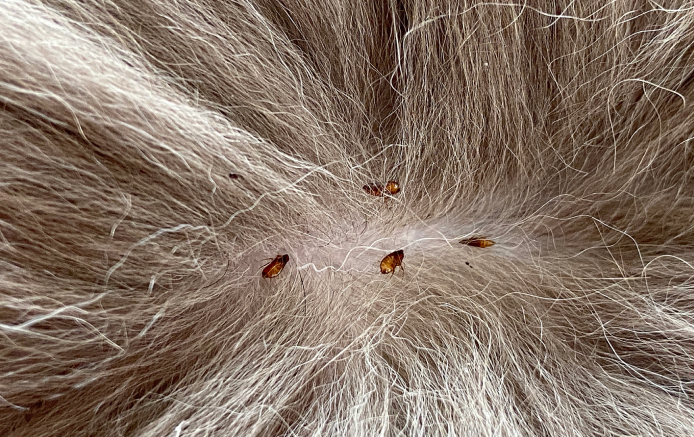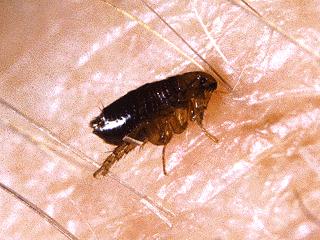Introduction: Understanding Fleas and Their Impact on Dogs
Fleas are more than just a nuisance for our canine friends. These tiny parasites, thriving in various environments, pose significant risks to dogs. Fleas feed on blood, leading to discomfort and potential health issues. Their life cycle, from egg to adult, can be rapid, making early detection crucial for effective control. …Click Here to Read more Fascinating Flea Articles.
In this guide, we delve into the signs of flea infestation in dogs. Recognizing these signs early is key to maintaining your dog’s health and comfort. We’ll explore physical indicators, health symptoms, and environmental evidence of fleas. Our aim is to arm you with knowledge for effective flea detection and control.
Understanding fleas begins with knowing their lifecycle. These parasites go through four stages: egg, larva, pupa, and adult. Each stage has unique characteristics, affecting how we detect and deal with them. The adult flea, which feeds on blood, is often the most noticeable stage, but understanding all stages is vital for comprehensive flea control.
Effective flea management is a combination of vigilance, timely intervention, and using the right methods. It’s not just about treating your pet; it’s also about addressing the environment they live in. By the end of this guide, you’ll be equipped with the knowledge to identify and tackle flea issues, ensuring your furry friend stays happy and healthy.

To further understand the nature of fleas and their lifecycle, refer to the Centers for Disease Control and Prevention’s detailed overview. This resource provides valuable insights into flea biology, helping you better grasp the importance of early detection and control.
In the following sections, we will break down the specific signs to watch for, health implications, and effective solutions. Stay tuned as we guide you through each aspect of dealing with fleas on dogs.
Physical Indicators: Visible Signs of Fleas on Your Dog
Detecting fleas on your dog often starts with noticing physical signs. These indicators are your first clue to a potential flea problem. We’ll look at flea bites, behavioral changes, and the presence of flea dirt. Recognizing these signs early can make a big difference in effectively managing a flea infestation.
Flea Bites:
The most direct sign of fleas are the bites themselves. These appear as small, red, raised bumps, primarily around the neck, back, and tail areas of your dog. Flea bites are often clustered and can cause intense itching. The discomfort caused by these bites can lead to more serious skin issues if not addressed promptly.
Excessive Scratching, Biting, or Licking:
Dogs infested with fleas exhibit noticeable changes in behavior. Watch for signs of excessive scratching, biting, or licking. These behaviors are your dog’s response to the irritation caused by flea bites. Constant scratching or licking can lead to skin damage, increasing the risk of infections.
Flea Dirt:
Flea dirt, essentially flea feces, is another clear indicator. It looks like tiny black specks in your dog’s coat, often found around the base of the tail or belly. To confirm it’s flea dirt, place some on a damp paper towel. If it turns red or brown, it’s a sign that it contains digested blood, confirming flea activity.
Each of these signs points to the presence of fleas and the need for action. Ignoring them can lead to more severe health issues for your dog. Early detection is crucial for effective flea control and maintaining your dog’s health and comfort. As we move forward, we will explore the health symptoms associated with flea infestations and the steps you can take to address them.
For a deeper understanding of flea bites and their impact on your pet, visit PetMD’s comprehensive article on the subject. This resource offers detailed insights into how flea bites affect dogs and cats, helping you recognize and respond to these signs effectively.
Health Symptoms: Flea Infestation and Its Effects on Dog’s Health
Beyond the immediate irritation, fleas can cause serious health issues in dogs. These symptoms can range from mild discomfort to severe medical conditions. It’s essential to recognize these symptoms early to ensure the well-being of your pet. We’ll cover skin infections, flea allergy dermatitis, and the risk of anemia in dogs due to flea infestations.
Skin Infections and Hair Loss:
Persistent scratching due to flea bites can lead to skin infections. These infections may manifest as red, inflamed areas, often accompanied by hair loss. The risk of infection increases with the severity and duration of the flea infestation. It’s crucial to treat these infections promptly to prevent further complications.
Flea Allergy Dermatitis:
Some dogs are allergic to flea saliva, leading to flea allergy dermatitis. This condition causes severe itching, redness, and swelling, often worse than typical flea bites. Dogs with this allergy can experience extreme discomfort, even from a single flea bite. Recognizing and addressing flea allergy dermatitis early is vital for your dog’s comfort and health.
Anemia in Severe Cases:
In extreme cases, particularly with heavy flea infestations, dogs can suffer from anemia. This condition arises when fleas feed on too much of the dog’s blood. Symptoms of anemia include lethargy, pale gums, and weakness. Anemia is a serious medical condition requiring immediate veterinary attention.
These health symptoms underscore the importance of addressing flea infestations promptly and effectively. Not only do fleas cause discomfort, but they can also lead to significant health risks for your dog. In the next sections, we’ll explore how to spot fleas in your environment and the best solutions for treating and preventing flea infestations.
For an in-depth look at the health implications of flea infestations on dogs, including flea allergy dermatitis and anemia, the American Kennel Club (AKC) provides a valuable resource. This article gives detailed information on the symptoms, treatment, and prevention of flea-related health issues, offering a comprehensive understanding for dog owners.
Environmental Evidence: Spotting Fleas in Your Home
Detecting a flea infestation isn’t limited to just examining your dog. Your home environment can also offer clues. Fleas can infest bedding, furniture, and other areas, making comprehensive control crucial. We’ll discuss how to spot fleas in your home, focusing on bedding and furniture, as well as identifying flea eggs and larvae.
Fleas on Bedding and Furniture: Fleas often take refuge in your dog’s bedding, your furniture, and even carpets. Regularly inspect these areas for signs of fleas. Look for tiny black dots (flea dirt) or actual fleas jumping around. Cleaning these areas thoroughly is essential in controlling a flea infestation.
Flea Eggs and Larvae: Fleas lay eggs that may fall off your pet onto various surfaces in your home. These eggs hatch into larvae, which then develop into pupae and eventually adult fleas. Spotting these early stages can be challenging but is critical for effective flea control. Pay attention to dark, less disturbed areas of your home, as fleas prefer these spots for their eggs and larvae.

Dealing with fleas in your home environment is as important as treating your pet. It’s a dual approach that ensures comprehensive control of the infestation. Vacuuming regularly, washing bedding at high temperatures, and using flea control products can significantly reduce the presence of fleas in your home.
For a detailed guide on identifying and dealing with fleas in the home, the Environmental Protection Agency (EPA) offers valuable tips and information. This resource provides practical advice on environmental flea control, aiding in the complete eradication of these pests from your home.
In the next section, we will delve into the various treatments and preventive measures available for flea infestations, both on your dog and in your home, ensuring a flea-free environment for you and your pet.
Effective Solutions: Treating and Preventing Flea Infestations
Once you’ve identified a flea infestation, the next step is effective treatment and prevention. Tackling fleas requires a dual approach: treating your dog and your home. We’ll explore topical treatments and oral medications, natural remedies, and when to seek professional help.
Topical Treatments and Oral Medications: For your dog, topical treatments and oral medications are highly effective. Topical treatments, applied directly to the skin, are great for ongoing flea prevention. Oral medications, which come in pill or chewable form, can kill fleas quickly and are easy to administer. Always consult with your vet to choose the best option for your dog.
Natural Remedies and Preventative Measures: If you prefer natural solutions, several options can help control fleas. Essential oils like lavender and eucalyptus can repel fleas, but use them cautiously, as some can be harmful to pets. Regular grooming and bathing your dog with flea-repellent shampoos can also keep fleas at bay. In your home, vacuuming regularly and using diatomaceous earth can help control fleas without chemicals.
Professional Intervention: In cases of severe infestations, professional intervention might be necessary. This could involve veterinary treatment for your dog and professional pest control services for your home. They can provide more potent solutions that are sometimes required to completely eradicate a stubborn flea problem.
Effective flea control is about both treating current infestations and preventing future ones. It requires consistent effort and vigilance. By following these steps, you can ensure your dog and your home stay flea-free.
Conclusion: Emphasizing Vigilance and Ongoing Flea Control
As we conclude this comprehensive guide on identifying and managing flea infestations in dogs, the key takeaway is the importance of vigilance and proactive measures. Flea control is an ongoing responsibility for pet owners, one that demands attention and consistent effort. Let’s summarize the critical points and reinforce the need for regular checks and preventive care.
Summary of Key Points: We’ve explored the various signs of flea infestations, including physical indicators on your dog, health symptoms, and environmental evidence. Understanding these signs is vital for early detection and effective treatment. We also delved into various treatment options, from medical interventions to natural remedies, and emphasized the importance of treating both your pet and your home.
Encouraging Regular Checks and Preventive Care: Regular inspections of your dog and your living environment are essential. Regular grooming, use of preventive medications, and maintaining a clean home environment are crucial steps in keeping fleas at bay. Remember, prevention is always better than cure, especially when it comes to fleas.
Closing and Invitation for Feedback: Your experiences and insights are valuable. If you’ve dealt with flea infestations or have tips to share, we invite you to comment below. Your input helps us all learn and grow in our journey to keep our pets healthy and happy.
Remember, flea control is a continuous process. It requires awareness, regular checks, and appropriate action. By staying vigilant and proactive, you can ensure your furry friend enjoys a comfortable, flea-free life.
For further information and ongoing support, feel free to visit our comprehensive resource center on flea control and pet care. Your pet’s health and happiness are our top priority. Thank you for joining us on this journey to effective flea management.